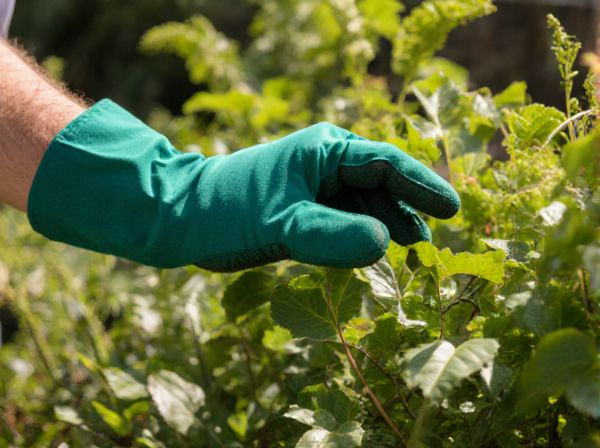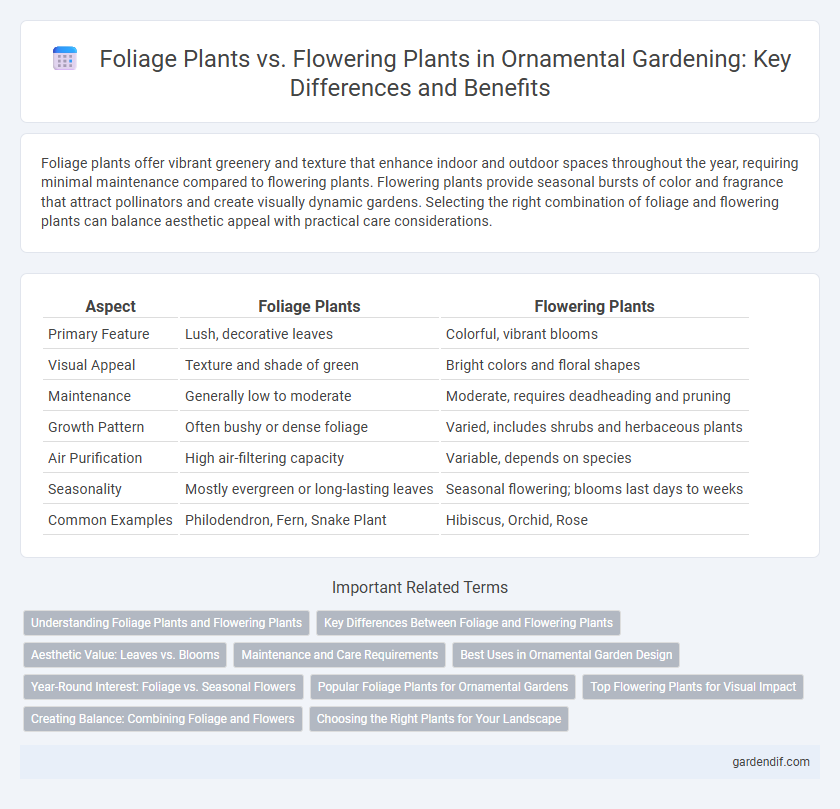
foliage plants vs flowering plants Illustration
Foliage plants offer vibrant greenery and texture that enhance indoor and outdoor spaces throughout the year, requiring minimal maintenance compared to flowering plants. Flowering plants provide seasonal bursts of color and fragrance that attract pollinators and create visually dynamic gardens. Selecting the right combination of foliage and flowering plants can balance aesthetic appeal with practical care considerations.
Table of Comparison
| Aspect | Foliage Plants | Flowering Plants |
|---|---|---|
| Primary Feature | Lush, decorative leaves | Colorful, vibrant blooms |
| Visual Appeal | Texture and shade of green | Bright colors and floral shapes |
| Maintenance | Generally low to moderate | Moderate, requires deadheading and pruning |
| Growth Pattern | Often bushy or dense foliage | Varied, includes shrubs and herbaceous plants |
| Air Purification | High air-filtering capacity | Variable, depends on species |
| Seasonality | Mostly evergreen or long-lasting leaves | Seasonal flowering; blooms last days to weeks |
| Common Examples | Philodendron, Fern, Snake Plant | Hibiscus, Orchid, Rose |
Understanding Foliage Plants and Flowering Plants
Foliage plants primarily enhance ornamental spaces through their lush, vibrant leaves that provide year-round greenery and texture, making them ideal for shaded or low-light areas. Flowering plants contribute colorful blooms that attract pollinators and seasonal interest, often requiring more sunlight and specific care to maintain flowering cycles. Understanding the growth requirements, light preferences, and maintenance needs of foliage versus flowering plants allows gardeners to create balanced and visually appealing landscapes.
Key Differences Between Foliage and Flowering Plants
Foliage plants primarily emphasize leaf structure, color, and texture, offering year-round visual interest with minimal maintenance, whereas flowering plants focus on blooms that provide seasonal color and fragrance but often require more care. Foliage plants typically have longer-lasting appeal due to their persistent greenery, while flowering plants highlight reproduction through striking flowers that attract pollinators. Key differences lie in their aesthetic purpose, growth habits, and maintenance needs, with foliage plants favored for greenery and durability, and flowering plants valued for vibrant, transient blooms.
Aesthetic Value: Leaves vs. Blooms
Foliage plants offer a rich palette of textures, shapes, and hues that create a lasting visual impact through their leaves, providing year-round greenery and architectural interest. Flowering plants capture attention with vibrant blooms that add seasonal bursts of color, enhancing garden aesthetics during their flowering period. The choice between foliage and flowering plants hinges on desire for continuous foliage beauty versus dynamic floral display.
Maintenance and Care Requirements
Foliage plants typically demand lower maintenance than flowering plants, requiring consistent watering and occasional fertilization to sustain vibrant leaf color and growth. Flowering plants often need more specialized care, including regular pruning, deadheading, and precise light conditions to encourage blooming and prevent disease. Both types benefit from pest monitoring and appropriate soil conditions, but flowering plants generally necessitate more attentive and tailored maintenance routines.
Best Uses in Ornamental Garden Design
Foliage plants excel in ornamental garden design by providing consistent texture, color, and structure throughout the year, making them ideal for creating lush, green backdrops and defining garden spaces. Flowering plants are best used to introduce seasonal color, attract pollinators, and create focal points with their vibrant blooms, adding dynamic interest and contrast to garden compositions. Combining foliage and flowering plants enhances garden complexity, balance, and aesthetic appeal by blending enduring greenery with periodic bursts of floral beauty.
Year-Round Interest: Foliage vs. Seasonal Flowers
Foliage plants provide consistent year-round interest through vibrant leaves, varied textures, and rich colors that remain attractive in all seasons. In contrast, flowering plants showcase seasonal blooms that add bursts of color and fragrance but typically have limited periods of visual impact. Selecting foliage plants ensures enduring landscape appeal, while flowering plants contribute dynamic, seasonal focal points.
Popular Foliage Plants for Ornamental Gardens
Popular foliage plants for ornamental gardens include varieties like hostas, ferns, and calatheas, prized for their diverse textures and vibrant leaf patterns. These plants require less maintenance than flowering plants and provide year-round greenery, enhancing garden aesthetics even when flowers are not in bloom. Their ability to thrive in shaded areas makes them versatile choices for complementing flowering species and creating layered garden designs.
Top Flowering Plants for Visual Impact
Top flowering plants such as petunias, marigolds, and geraniums deliver striking visual impact through vibrant colors and dynamic blooms, making them ideal choices for enhancing ornamental gardens. These plants thrive in various climates, offering seasonal versatility and attracting pollinators like butterflies and bees, which enrich garden biodiversity. Their diverse shapes and sizes allow for creative landscape designs that emphasize focal points and color contrast, setting them apart from foliage plants primarily valued for texture and greenery.
Creating Balance: Combining Foliage and Flowers
Creating balance in ornamental gardening involves harmonizing the rich textures of foliage plants with the vibrant colors of flowering plants. Foliage plants, such as hostas and ferns, provide structural depth and year-round greenery, while flowering plants like petunias and marigolds contribute seasonal bursts of color. Blending these elements ensures visual interest and a dynamic landscape design that appeals throughout the seasons.
Choosing the Right Plants for Your Landscape
Foliage plants provide year-round texture and color with their diverse leaf shapes, sizes, and shades, making them essential for creating depth in any landscape design. Flowering plants offer seasonal bursts of color and fragrance that attract pollinators and enhance visual interest, ideal for focal points and garden highlights. Selecting the right balance of foliage and flowering plants ensures a dynamic, low-maintenance landscape that maintains aesthetic appeal throughout the year.
foliage plants vs flowering plants Infographic

 gardendif.com
gardendif.com